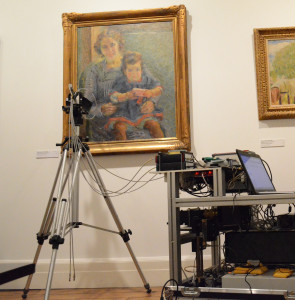
Both ultraviolet and visibile sources can be used for UV-VIS absorption and emission spectroscopy, a technique used for the identification and study of historical colourants (for example insoluble precipitates of dyes, including lake pigments) and for modern synthetic materials. The analysis of inorganic modern materials including the semi-conductor pigments (including yellow and red Cadmium-based pigments and ZnO) is also interesting. By varying the radiation used for analysis it is possible to acquire both reflectance and luminescence spectra. It is also possible to calculate the fluorescence lifetime of samples.
The instrument is based on a prototype which can measure both reflection (and hence absorption) and emission both in steady-state and time-resolved modalities. Absorption can be measured between 200 nm and 1100 nm (with spectral resolution of 8 nm) based on a Deutrium halogen lamp (AvaLight-Dhc, Avantes) and a detector (Avaspec 2048 USB2) sensitive between 270-1400 nm. A sensitive Horiba photocathode coupled with necessary electronics is used to measure fluorescence lifetime using Time Correlated Single Photon Counting. A system of fibre optic probes is coupled to the instrument (Avantes).
References:
Aldo Romani, Catia Clementi et al. Fluorescence Spectroscopy: A Powerful Technique for the Noninvasive Characterization of Artwork Account of Chemical Research 43, 2010 pp. 761-770 and references therein.
Aldo Romani, Chiara Grazia, et al. New portable instrument for combined reflectance, time-resolved and steady-state luminescence measurements on works of art, O3A: Optics for Arts, Architecture, and Archaeology III, edited by Luca Pezzati, Renzo Salimbeni, Proc. of SPIE Vol. 8084, 808403.
Aldo Romani, Catia Clementi et al. Portable equipment for luminescence lifetime measurements on surfaces. Appl Spectrosc. 2008 62: 1395-9.
